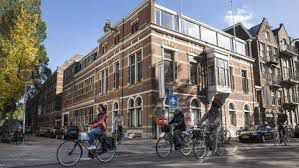

This stretch along the quay of the Amstel river is mostly known for its monumental 19th century houses and the houseboats moored at the waterfront. The street and the neighborhood adjacent to it to the east came into existence after the Watergraafsmeer inlet was reclaimed from the sea in 1629. This road became the main road out of Amsterdam towards the town of Weesp, hence the name, which can literally be translated as the Weesp Side. It was adapted for leisure and entertainment quite quickly. Along its stretch there were taverns with moorings for boating, which later turned into rowing clubs Poseidon and De Hoop. From 1884 to 1904 an omnibus, and then until 1942 an electric tram, serviced the quay; however today this is one of Amsterdam's busiest arteries for bicycle traffic which connects the modern business cluster at the Amstel Station with the city center. The latter area, known as Omval, which now features the tallest buildings in the Netherlands - The Rembrandt Tower, the Mondriaan Tower and the Breitner Tower in the past served as an industrial quarter with canning, cocoa and chocolate factories.
The first buildings at Weesperzijde dating back to the 17th century have all but disappeared. Partially because this was an open waterfront and partially thanks to the leisure activities provided by the river and, in the winter months, ice, in the nineteenth and twentieth centuries this area was mostly settled by the upper class. Weesperzijde is still famous for its quasi-posh cafés such the journalists café Hesp and the student café Lax.
Formerly a tavern, the Grand Café De Ysbreeker at number 23, as well as the monumental Spiegelpanden houses around the corner along the Ruyschstraat, built in the end of 19th century by the architect van Gendt, who also designed the Concertgebouw at the Museum Square, were commissioned by the construction company De Ijsbreeker. This illustrious café, which is listed as a monument and which has recently been fully renovated, is well worth a visit. It has been a center for the intellectual and media elite and it is one of the most popular open terraces during Amsterdam's mild, if often brief, summers.
The name of this café, which literally translates as the ice breaker, was inspired by the fact that between 1702 and 1860, during the winter season, the ice covering Amstel river needed to be broken up to have the supply of fresh water and to keep the river navigable for ships heading towards the IJ. The barge used for this purpose was pulled along the entire stretch of the Amstel by horses. In the summer months it was moored approximately across the road from where the café now stands.